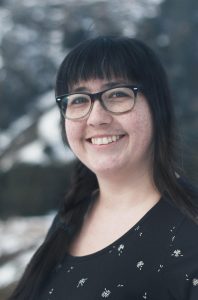
We are thrilled to present emerging artist Melissa Tremblett, who has much to celebrate this month: not only is she our Member of the Month, but she is part of a group show tet; mâni; ute | here, opening at the Eastern Edge Gallery.
About the artist
“Coming to an understanding that my art is a product of myself and putting my art into the world opens myself to genuine conversation.”
Melissa Tremblett is a visual artist of Innu and English heritage who works mainly in fibre art and installation, but also enjoys photography, printmaking, and performance.
A recent visual arts grad, Melissa studied art at Grenfell College after first obtaining a behavioural neuroscience degree from MUN in 2011. Since completing her BFA in 2015, her accomplishments have been many. Her work has been exhibited both nationally and abroad (The Rooms; Tina Dolter Gallery; Gatehouse Arts, Essex; Art Gallery of Ontario; and the British Museum, London) and she is the recipient of the the Short Family Award, Mercy/Presentation Education Fund Award, and a Professional Project Grant through the Newfoundland and Labrador Arts Council.
Tremblett, who now lives in Corner Brook, grew up in Sheshatshiu, Labrador, but moved to Newfoundland with her family when she was just three. She did all of her schooling in Newfoundland but spent her summers in Sheshatshiu and other coastal communities in northern Labrador. Living between the Innu community of Sheshatshiu in Labrador and the island of Newfoundland has had a profound influence on her work.
Can you talk to us about themes in your art?
The themes I work with depend on what I am processing in my personal life. I work using concepts as they present themselves. Some concepts I have worked with previously are: identity, self-discovery, acceptance and forgiveness. Currently I am working towards spiritual healing.
Feelings of disconnection and not belonging have had a large impact on my life starting in childhood. One example would involve language. In Sheshatshiu, the first language is Innu-Aimun [Innu], but since I left when I was just three I didn’t learn how to speak it. When I was home, people would speak to me in English, but they would turn to one another and speak in Innu—I was never able to understand what was going on around me. This is a theme which materializes in my art practice; I feel that I lost opportunities to learn how to communicate.
How would you describe your artwork?
My art practice stemmed from a need to process experiences and emotions. My first experience making art was during art therapy when I was 19. I hadn’t had much success with verbal therapies, and as soon as I started using art as a way of expression my healing journey began.
Knowing that art was a therapeutic process, I used my time in the visual arts program to learn new ways of expressing myself. I fell in love with photography, printmaking, and performance (I already had a love for textiles). I learned about conceptual art while at Grenfell which suited my emerging practice where the process of making art was equally, or more, important than the final product.
Can you describe your art career so far?
In the beginning I wasn’t prepared for the feedback I was receiving about how my work has affected people. I had been terrified about showing my work, as it was so personal and I didn’t think anyone would get it; the response was overwhelming. I can fully appreciate how my art is reflected in others’ experience and takes a new meaning for every viewer. And that has contributed immensely to my confidence as an artist.
I don’t keep regular studio hours at this point. I am working full time and I use any time I have during the week to work on things. I do spend a lot of time reflecting and mentally working through concepts and possibilities. I try to keep notes about ideas I have and refer back to them as needed.
I also enjoy researching definitions and origins of words that intrigue me. For instance, the word vestige has interested me for some time. Doing research through the lens of my personal experience, a concept emerged which eventually evolved into my previous solo exhibition 1876 changed my life.
Can you share with us any funny stories that you have experienced along your art path?
When applying to the BFA program there was an option to send a digital submission. I had no idea how to use a camera or work with digital things. So I packed my actual art: three large boxes with things like VHS tapes stuck to mirrors with the tape hauled out and dream catchers made in picture frames. I was late to the last final of my neuroscience degree because it took so long at Purolator trying to sort out and send the boxes to Corner Brook.
What advice would you tell others emerging artists.
I would say to listen to your heart and make the kind of art that nourishes you. If working in an environment such as university for example, where conceptual limitations can be used as parameters, make the art you need to make anyway. Don’t be limited by your own judgements and expectations and don’t ever allow yourself to be limited by anyone else’s expectations.
I am the only person I have to live with at the end of the day and when I sacrifice my personal integrity to fit within artificial parameters, it is a disservice. When I understood that concepts are just jumping off points and not limiting factors, I was able to thrive and develop into the artist I am today.
Whats next?
I look forward to hopefully work in my community more in the future and creating collaborations and programs to facilitate healing through art.
2018 (upcoming) Reclamation, Government House, St. John’s, NL
Where to see Melissa’s work now
tet; mâni; ute | here,
with John Jeddore and curated by Joanna Barker, is at Eastern Edge in the main gallery from April 21st-June 2nd, 2018.
Instagram: melissatremblettart
Website: melissatremblett.wixsite.comartist
